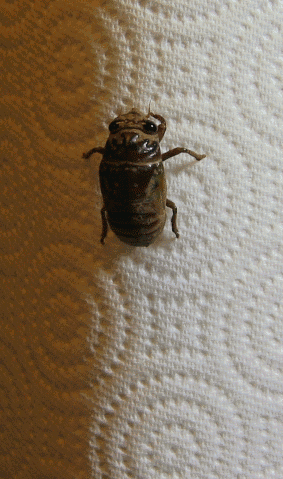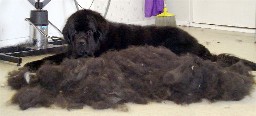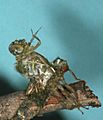Moulting facts for kids
Moulting is when an animal sheds part of its body. This usually happens at certain times of the year. It can also happen at different stages of an animal's life. Other names for moulting include shedding or sloughing. For some animals, it's called ecdysis.
Animals can shed their skin, hair, fur, or feathers. Some insects even shed their wings! Think of birds losing old feathers or dogs shedding fur. Reptiles like snakes and lizards shed their old skin. Arthropods, like insects and crabs, shed their hard outer shell, called an exoskeleton.
Contents
Animals That Moult
Many different animals moult. Here are some common examples:
Birds

Chickens usually moult in the autumn. They shed their old feathers. Chickens often stop laying eggs before they moult. They start laying again once their new feathers have grown back.
Mammals
Dogs and other canids (like wolves) shed their hair or fur. This often happens twice a year, in spring and autumn. This shedding is linked to how much melatonin their bodies make. Melatonin levels change with the amount of sunlight each season. This is why Arctic dogs shed a lot in spring and fall. Other dog breeds might shed hair all year round.
Reptiles
Snakes shed their skin regularly. They do this when they outgrow their old skin. Snakes will rub against rough surfaces to help pull off their old skin. Lizards also shed their skin regularly. They often eat their shed skin. This helps them get back important nutrients like calcium.
Amphibians
Amphibians like salamanders and frogs shed their skin regularly. They often eat their shed skin too.
Crustaceans
Hermit crabs shed their exoskeleton (outer shell). They do this when they get too big for their old shell. Land hermit crabs often bury themselves for many weeks while they moult. They also eat their old exoskeleton.
Ecdysis: Shedding for Arthropods
In arthropods, like insects, arachnids (spiders), and crustaceans (crabs, lobsters), moulting means shedding their exoskeleton. This hard outer shell does not grow with the animal. So, the animal must shed it to get bigger.
This special type of moulting is called ecdysis. It's a key feature for a whole group of invertebrates called Ecdysozoa. This group includes arthropods, nematodes (roundworms), and tardigrades (water bears). When these animals grow, their outer layer, or cuticle, often forms a stiff exoskeleton. Because it can't stretch, they shed it. Then, a new, larger covering forms.
Ecdysis is part of a bigger process called metamorphosis. This is when an animal changes its form completely. For example, a caterpillar changes into a butterfly. Each stage of growth is called an 'instar'. During ecdysis, the animal might also develop new body parts, like sense organs. The new exoskeleton is soft at first. It then hardens after the old one has been shed.
Images for kids
-
A king penguin with new feathers growing.
-
A moulting yellow-eyed penguin.
-
A Giant prickly stick insect crawling out of its old skin.
-
A moulting European green lizard.
-
The discarded skin of a grasshopper.
-
Shed skin from a Tiliqua rugosa lizard.
See also
 In Spanish: Muda (biología) para niños
In Spanish: Muda (biología) para niños













